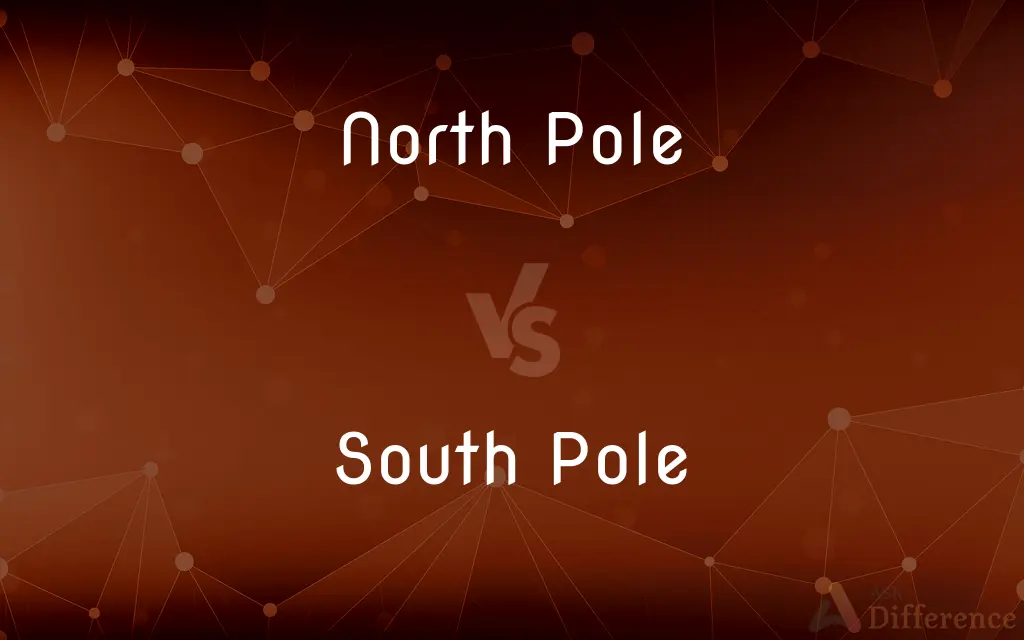North Pole vs. South Pole — What's the Difference?
By Tayyaba Rehman — Published on October 29, 2023
The North Pole is the northernmost point on Earth; the South Pole is the southernmost. Both are opposite extremities of Earth's axis.

Difference Between North Pole and South Pole
Table of Contents
ADVERTISEMENT
Key Differences
The North Pole, situated in the Arctic Ocean, is largely an ice-covered sea. The South Pole, in contrast, is on Antarctica, a solid ice-covered continent.
Both the North Pole and the South Pole experience continuous daylight or darkness for six months. However, the North Pole gets continuous sunlight from March to September, while the South Pole experiences it from September to March.
Polar bears are native to the North Pole region, whereas the South Pole boasts penguins, which are not found in the north. Interestingly, the North Pole's ice is constantly moving due to ocean currents, but the South Pole remains stationary on the Antarctic continent. Magnetic variations exist between the North Pole and the South Pole.
The North Pole aligns with Earth's magnetic field, while the South Pole aligns oppositely; however, these positions can switch over long geological timescales.
Comparison Chart
Geographic Location
Northernmost point on Earth
Southernmost point on Earth
ADVERTISEMENT
Terrain
Floating sea ice
Ice-covered continent
Typical Wildlife
Polar bears, seals
Penguins, seals
Magnetic Alignment
Aligns with Earth's magnetic field
Opposite of Earth's magnetic field
Daylight Duration
Continuous daylight from March to September
Continuous daylight from September to March
Compare with Definitions
North Pole
North Pole is an imaginary geographic point from which all directions are south.
The North Pole remains elusive to many explorers.
South Pole
South Pole is characterized by a stable ice-covered landmass.
Unlike the North Pole, the South Pole is not floating sea ice.
North Pole
North Pole is the point on Earth where the planet's axis of rotation meets its surface.
The expedition's aim was to reach the North Pole.
South Pole
South Pole marks the southernmost point of the terrestrial globe.
The South Pole has been a goal for many adventurers.
North Pole
North Pole represents the northernmost point of the terrestrial globe.
Few people have ever stood at the North Pole.
South Pole
South Pole is an imaginary geographic point from which all directions are north.
Daylight at the South Pole lasts for six continuous months.
North Pole
North Pole is the location that aligns with Earth's magnetic north.
Compasses point towards the North Pole.
South Pole
South Pole is located on the frozen Antarctic continent.
Scientific research stations operate near the South Pole.
North Pole
North Pole is characterized by extreme cold temperatures and polar conditions.
Life at the North Pole is limited due to its harsh environment.
South Pole
South Pole is the point on Earth opposite the North Pole, where the planet's axis of rotation meets its surface.
The South Pole is located on the continent of Antarctica.
Common Curiosities
Which Pole is on a solid continent?
The South Pole is on Antarctica, a solid ice-covered continent.
What animals are typically associated with the North Pole?
Polar bears and seals are commonly associated with the North Pole.
Where is the North Pole located?
The North Pole is located in the middle of the Arctic Ocean.
Where is the South Pole situated?
The South Pole is on the continent of Antarctica.
Does the sun ever set at the North Pole?
Yes, the North Pole experiences continuous darkness from September to March.
Can I find penguins at the North Pole?
No, penguins are native to the South Pole region, not the North Pole.
Why is the South Pole so important for scientific research?
The South Pole offers unique insights into climate history, geology, and other scientific phenomena.
Are there permanent structures at the North Pole?
No, the North Pole is on floating sea ice, which is constantly moving.
Are there trees at the North Pole?
No, the North Pole is characterized by floating sea ice with no vegetation.
How long does the South Pole experience daylight?
The South Pole gets continuous daylight from September to March.
Are there research stations near the South Pole?
Yes, there are scientific research stations near the South Pole.
What's the difference in magnetic alignment between the North Pole and South Pole?
The North Pole aligns with Earth's magnetic field, while the South Pole aligns oppositely.
Can I visit the South Pole?
Yes, but visits are typically part of guided tours or scientific expeditions due to the harsh environment.
Does the South Pole move like the North Pole?
No, the South Pole is stationary as it's on a solid continent, unlike the North Pole's floating ice.
Is the North Pole warmer than the South Pole?
Generally, the North Pole can be slightly warmer due to ocean currents, but both are extremely cold.
Share Your Discovery

Previous Comparison
Chips vs. Waffers
Next Comparison
Initiative vs. ReferendumAuthor Spotlight
Written by
Tayyaba RehmanTayyaba Rehman is a distinguished writer, currently serving as a primary contributor to askdifference.com. As a researcher in semantics and etymology, Tayyaba's passion for the complexity of languages and their distinctions has found a perfect home on the platform. Tayyaba delves into the intricacies of language, distinguishing between commonly confused words and phrases, thereby providing clarity for readers worldwide.













































